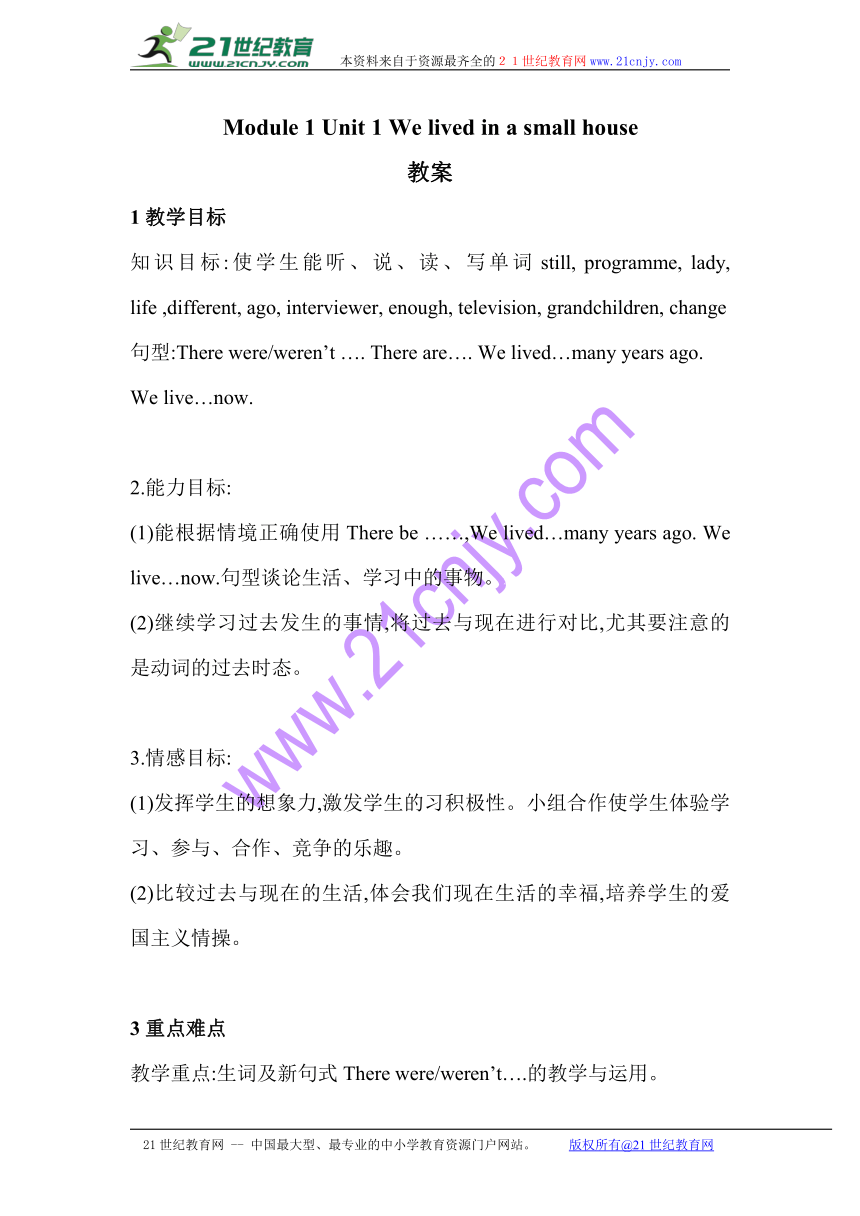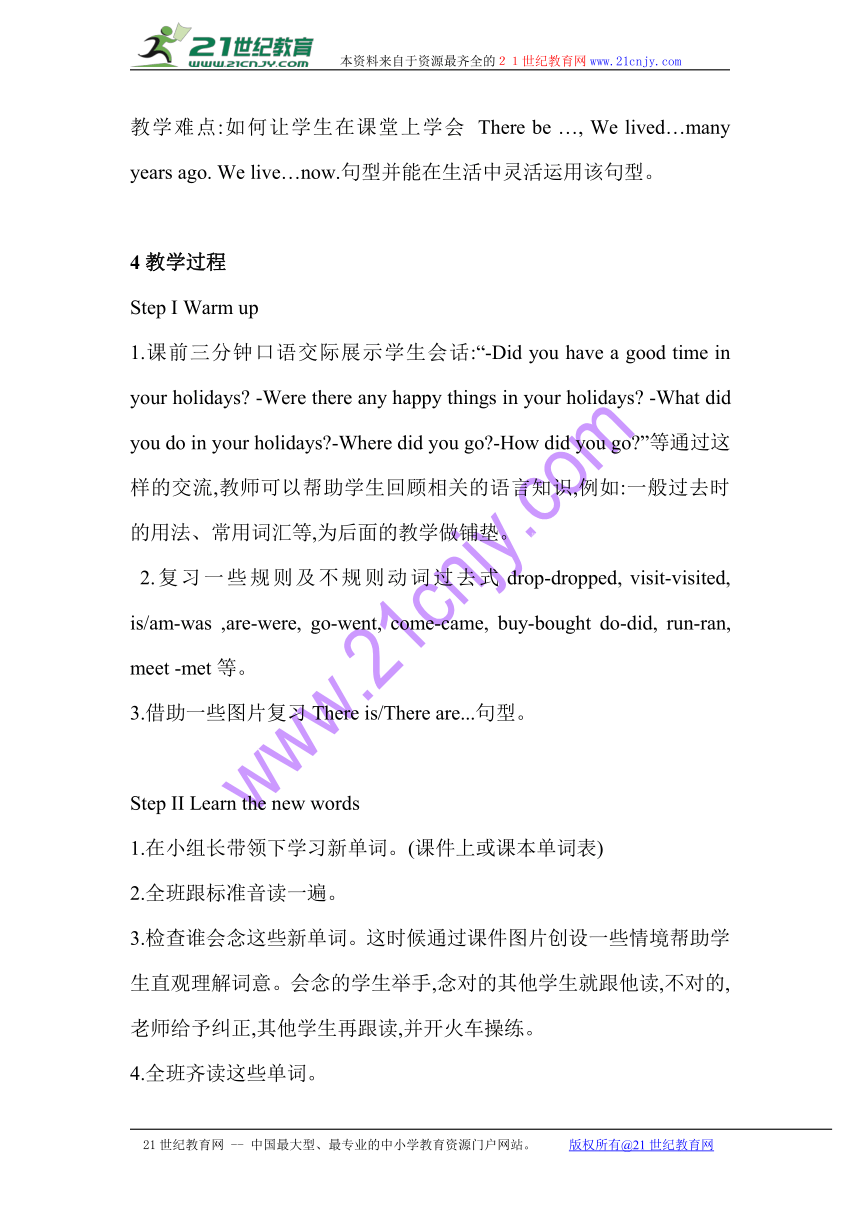Unit 1 We lived in a small house 教案
文档属性
| 名称 | Unit 1 We lived in a small house 教案 |  | |
| 格式 | zip | ||
| 文件大小 | 118.6KB | ||
| 资源类型 | 教案 | ||
| 版本资源 | 外研版(三年级起点) | ||
| 科目 | 英语 | ||
| 更新时间 | 2017-03-14 22:34:24 | ||
图片预览


文档简介
本资料来自于资源最齐全的21世纪教育网www.21cnjy.com
Module
1
Unit
1
We
lived
in
a
small
house
教案
1教学目标
知识目标:使学生能听、说、读、写单词still,
programme,
lady,
life
,different,
ago,
interviewer,
enough,
television,
grandchildren,
change
句型:There
were/weren’t
….
There
are….
We
lived…many
years
ago.
We
live…now.
2.能力目标:
(1)能根据情境正确使用There
be
……,We
lived…many
years
ago.
We
live…now.句型谈论生活、学习中的事物。21世纪教育网版权所有
(2)继续学习过去发生的事情,将过去与现在进行对比,尤其要注意的是动词的过去时态。
3.情感目标:
(1)发挥学生的想象力,激发学生的习积极性。小组合作使学生体验学习、参与、合作、竞争的乐趣。
(2)比较过去与现在的生活,体会我们现在生活的幸福,培养学生的爱国主义情操。
3重点难点
教学重点:生词及新句式There
were/weren’t….的教学与运用。
教学难点:如何让学生在课堂上学会
There
be
…,
We
lived…many
years
ago.
We
live…now.句型并能在生活中灵活运用该句型。
4教学过程
Step
I
Warm
up
1.课前三分钟口语交际展示学生会话:“-Did
you
have
a
good
time
in
your
holidays
-Were
there
any
happy
things
in
your
holidays
-What
did
you
do
in
your
holidays -Where
did
you
go -How
did
you
go ”等通过这样的交流,教师可以帮助学生回顾相关的语言知识,例如:一般过去时的用法、常用词汇等,为后面的教学做铺垫。21教育网
2.复习一些规则及不规则动词过去式drop-dropped,
visit-visited,
is/am-was
,are-were,
go-went,
come-came,
buy-bought
do-did,
run-ran,
meet
-met等。21·cn·jy·com
3.借助一些图片复习There
is/There
are...句型。
Step
II
Learn
the
new
words
1.在小组长带领下学习新单词。(课件上或课本单词表)
2.全班跟标准音读一遍。
3.检查谁会念这些新单词。这时候通过课件图片创设一些情境帮助学生直观理解词意。会念的学生举手,念对的其他学生就跟他读,不对的,老师给予纠正,其他学生再跟读,并开火车操练。www.21-cn-jy.com
4.全班齐读这些单词。
5.在组长带领下小组内读单词并展示。
6.抽号检查单词的掌握情况。
Step
III
Leading
in
the
topic
of
the
text.
T:After
the
new
year,
we
had
lots
of
changes.
Yes,
no
changes.no
progress.引出change-changing.
Now
Lingling
is
still
in
England
with
Sam
and
Amy.
They
are
watching
a
programmer
about
changing.
Please
look
and
listen.【来源:21·世纪·教育·网】
Step
IV
Text
teaching
Listen
to
the
tape
once.
Think
about:
What’s
the
programmer
about
It’s
about___China_______.
2.
分段听录音。
(1)T:
What’s
the
changing
in
China
How
was
the
life
different
in
China
many
years
ago 看图,听录音第二段,(也可以看动画视频),填词。
Old
lady:
We
lived
in
a
small
house.
We
_______
didn’t
have
enough
food.
There
weren’t
any
buses.
There
weren’t
any
televisions.
T:
How
about
the
life
now
看图,听第三段录音。填词。
Interviewer:
How
about
now
Old
lady:
We
live
in
a
big
house.
We
have
got
lots
of
food.
There
are
lots
of
buses
and
cars.
I
watch
TV
every
day.21·世纪
教育网
Yesterday
I
watched
TV
with
my
grandchildren.
T
Interviewer:
Thanks
for
_talking__
to
us.www-2-1-cnjy-com
(3)
看图,听第三段录音。填词。
Amy:
China
is
changing.
Lingling:
I
miss
China!
I
miss
my
grandmother.
3.
Listen
to
the
tape
and
repeat.
4.
The
whole
class
read
the
text
together.
5.
Read
the
text
in
groups.
6.
Show
the
text
in
groups.2-1-c-n-j-y
Step
V
Discussion.
(课文在分别描述中国过去的生活状况及现在的生活状况时句型有何不同 小组内讨论并填空。)
Many
years
ago
(多年以前)
Now
(现在)
We
lived
in
a
small
house.
We
live
in
a
big
house.21
cnjy
com
We
didn’t
have
enough
food.
We
have
got
lots
of
food.【出处:21教育名师】
There
weren’t
any
buses.
There
are
lots
of
buses
and
cars.
There
weren’t
any
televisions.
I
watch
TV
every
day.【来源:21cnj
y.co
m】
Step
VI
给一些组的代表发言,小结:
表示过去“有”
表示现在“有”
(单数)There
was…
There
is…
(复数)
There
were…
There
are…
表示过去“没有”
表示现在“没有”
(单数)
There
wasn’t…
There
isn’t…
(复数)
There
weren’t…
There
aren’t…
Step
VII
.Look,
listen
and
say
in
part
1
Step
VIII拓展运用(课本活动4)There
be
结构单数的运用。
_____
_____
a
small
house
four
years
ago.
A
little
boy
______in
it.
______in
it
.There
_____a
small
tree.21cnjy.com
Now
______
___a
big
house.
He
________in
it.
_____
____a
big
tree.
And
_____
____three
dogs.
He
____listening
to
music.
Step
IX.
Summary
and
do
the
homework:回家后问问自己的爷爷、奶奶、外公或外婆,他们以前的生活与现在的生活有什么不一样。比较过去与现在的生活体会到我们现在生活在社会主义幸福感。把结果在下节课用英语告诉老师和同学.2·1·c·n·j·y
21世纪教育网
--
中国最大型、最专业的中小学教育资源门户网站。
版权所有@21世纪教育网
Module
1
Unit
1
We
lived
in
a
small
house
教案
1教学目标
知识目标:使学生能听、说、读、写单词still,
programme,
lady,
life
,different,
ago,
interviewer,
enough,
television,
grandchildren,
change
句型:There
were/weren’t
….
There
are….
We
lived…many
years
ago.
We
live…now.
2.能力目标:
(1)能根据情境正确使用There
be
……,We
lived…many
years
ago.
We
live…now.句型谈论生活、学习中的事物。21世纪教育网版权所有
(2)继续学习过去发生的事情,将过去与现在进行对比,尤其要注意的是动词的过去时态。
3.情感目标:
(1)发挥学生的想象力,激发学生的习积极性。小组合作使学生体验学习、参与、合作、竞争的乐趣。
(2)比较过去与现在的生活,体会我们现在生活的幸福,培养学生的爱国主义情操。
3重点难点
教学重点:生词及新句式There
were/weren’t….的教学与运用。
教学难点:如何让学生在课堂上学会
There
be
…,
We
lived…many
years
ago.
We
live…now.句型并能在生活中灵活运用该句型。
4教学过程
Step
I
Warm
up
1.课前三分钟口语交际展示学生会话:“-Did
you
have
a
good
time
in
your
holidays
-Were
there
any
happy
things
in
your
holidays
-What
did
you
do
in
your
holidays -Where
did
you
go -How
did
you
go ”等通过这样的交流,教师可以帮助学生回顾相关的语言知识,例如:一般过去时的用法、常用词汇等,为后面的教学做铺垫。21教育网
2.复习一些规则及不规则动词过去式drop-dropped,
visit-visited,
is/am-was
,are-were,
go-went,
come-came,
buy-bought
do-did,
run-ran,
meet
-met等。21·cn·jy·com
3.借助一些图片复习There
is/There
are...句型。
Step
II
Learn
the
new
words
1.在小组长带领下学习新单词。(课件上或课本单词表)
2.全班跟标准音读一遍。
3.检查谁会念这些新单词。这时候通过课件图片创设一些情境帮助学生直观理解词意。会念的学生举手,念对的其他学生就跟他读,不对的,老师给予纠正,其他学生再跟读,并开火车操练。www.21-cn-jy.com
4.全班齐读这些单词。
5.在组长带领下小组内读单词并展示。
6.抽号检查单词的掌握情况。
Step
III
Leading
in
the
topic
of
the
text.
T:After
the
new
year,
we
had
lots
of
changes.
Yes,
no
changes.no
progress.引出change-changing.
Now
Lingling
is
still
in
England
with
Sam
and
Amy.
They
are
watching
a
programmer
about
changing.
Please
look
and
listen.【来源:21·世纪·教育·网】
Step
IV
Text
teaching
Listen
to
the
tape
once.
Think
about:
What’s
the
programmer
about
It’s
about___China_______.
2.
分段听录音。
(1)T:
What’s
the
changing
in
China
How
was
the
life
different
in
China
many
years
ago 看图,听录音第二段,(也可以看动画视频),填词。
Old
lady:
We
lived
in
a
small
house.
We
_______
didn’t
have
enough
food.
There
weren’t
any
buses.
There
weren’t
any
televisions.
T:
How
about
the
life
now
看图,听第三段录音。填词。
Interviewer:
How
about
now
Old
lady:
We
live
in
a
big
house.
We
have
got
lots
of
food.
There
are
lots
of
buses
and
cars.
I
watch
TV
every
day.21·世纪
教育网
Yesterday
I
watched
TV
with
my
grandchildren.
T
Interviewer:
Thanks
for
_talking__
to
us.www-2-1-cnjy-com
(3)
看图,听第三段录音。填词。
Amy:
China
is
changing.
Lingling:
I
miss
China!
I
miss
my
grandmother.
3.
Listen
to
the
tape
and
repeat.
4.
The
whole
class
read
the
text
together.
5.
Read
the
text
in
groups.
6.
Show
the
text
in
groups.2-1-c-n-j-y
Step
V
Discussion.
(课文在分别描述中国过去的生活状况及现在的生活状况时句型有何不同 小组内讨论并填空。)
Many
years
ago
(多年以前)
Now
(现在)
We
lived
in
a
small
house.
We
live
in
a
big
house.21
cnjy
com
We
didn’t
have
enough
food.
We
have
got
lots
of
food.【出处:21教育名师】
There
weren’t
any
buses.
There
are
lots
of
buses
and
cars.
There
weren’t
any
televisions.
I
watch
TV
every
day.【来源:21cnj
y.co
m】
Step
VI
给一些组的代表发言,小结:
表示过去“有”
表示现在“有”
(单数)There
was…
There
is…
(复数)
There
were…
There
are…
表示过去“没有”
表示现在“没有”
(单数)
There
wasn’t…
There
isn’t…
(复数)
There
weren’t…
There
aren’t…
Step
VII
.Look,
listen
and
say
in
part
1
Step
VIII拓展运用(课本活动4)There
be
结构单数的运用。
_____
_____
a
small
house
four
years
ago.
A
little
boy
______in
it.
______in
it
.There
_____a
small
tree.21cnjy.com
Now
______
___a
big
house.
He
________in
it.
_____
____a
big
tree.
And
_____
____three
dogs.
He
____listening
to
music.
Step
IX.
Summary
and
do
the
homework:回家后问问自己的爷爷、奶奶、外公或外婆,他们以前的生活与现在的生活有什么不一样。比较过去与现在的生活体会到我们现在生活在社会主义幸福感。把结果在下节课用英语告诉老师和同学.2·1·c·n·j·y
21世纪教育网
--
中国最大型、最专业的中小学教育资源门户网站。
版权所有@21世纪教育网
同课章节目录
- Module 1
- Unit 1 We lived in a small house.
- Unit 2 She didn't have a television.
- Module 2
- Unit 1 She learnt English.
- Unit 2 Mr Li was a teacher.
- Module 3
- Unit 1 She had eggs and sausages.
- Unit 2 Sam ate four hamburgers.
- Module 4
- Unit 1 Let's make a home library.
- Unit 2 We can find information from books and CDs.
- Module 5
- Unit 1 It's big and light.
- Unit 2 It's too big for you.
- Module 6
- Unit 1 I went there last year.
- Unit 2 She visited the Tianchi Lake.
- Module 7
- Unit 1 My father goes to work at eight o'clock eve
- Unit 2 I'll be home at seven o'clock.
- Module 8
- Unit 1 Will you help me?
- Unit 2 I made a kite.
- Module 9
- Unit 1 We laughed a lot.
- Unit 2 Mum bought new T-shirts for you.
- Module 10
- Unit 1 Where are you going to go?
- Unit 2 I'm in New York now.
- Review Module
- Unit 1
- Unit 2
